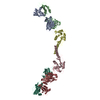+ Open data
Open data
- Basic information
Basic information
| Entry | Database: PDB / ID: 8w8t | ||||||
|---|---|---|---|---|---|---|---|
| Title | Crystal structure of human CLEC12A CRD | ||||||
 Components Components | C-type lectin domain family 12 member A | ||||||
 Keywords Keywords |  IMMUNE SYSTEM / IMMUNE SYSTEM /  Pattern Recognition Receptor / Innate immunitiy / C-type lectin receptor / DAMPs Pattern Recognition Receptor / Innate immunitiy / C-type lectin receptor / DAMPs | ||||||
| Function / homology |  Function and homology information Function and homology informationsignaling receptor regulator activity / tertiary granule membrane / specific granule membrane / transmembrane signaling receptor activity /  carbohydrate binding / Neutrophil degranulation / carbohydrate binding / Neutrophil degranulation /  signal transduction / signal transduction /  plasma membrane plasma membraneSimilarity search - Function | ||||||
| Biological species |   Homo sapiens (human) Homo sapiens (human) | ||||||
| Method |  X-RAY DIFFRACTION / X-RAY DIFFRACTION /  SYNCHROTRON / SYNCHROTRON /  MOLECULAR REPLACEMENT / Resolution: 2.3 Å MOLECULAR REPLACEMENT / Resolution: 2.3 Å | ||||||
 Authors Authors | Mori, S. / Nagae, M. / Yamasaki, S. | ||||||
| Funding support |  Japan, 1items Japan, 1items
| ||||||
 Citation Citation |  Journal: Int.Immunol. / Year: 2024 Journal: Int.Immunol. / Year: 2024Title: Crystal structure of the complex of CLEC12A and an antibody that interferes with binding of diverse ligands. Authors: Mori, S. / Nagae, M. / Yamasaki, S. | ||||||
| History |
|
- Structure visualization
Structure visualization
| Structure viewer | Molecule:  Molmil Molmil Jmol/JSmol Jmol/JSmol |
|---|
- Downloads & links
Downloads & links
- Download
Download
| PDBx/mmCIF format |  8w8t.cif.gz 8w8t.cif.gz | 140.1 KB | Display |  PDBx/mmCIF format PDBx/mmCIF format |
|---|---|---|---|---|
| PDB format |  pdb8w8t.ent.gz pdb8w8t.ent.gz | 90.9 KB | Display |  PDB format PDB format |
| PDBx/mmJSON format |  8w8t.json.gz 8w8t.json.gz | Tree view |  PDBx/mmJSON format PDBx/mmJSON format | |
| Others |  Other downloads Other downloads |
-Validation report
| Arichive directory |  https://data.pdbj.org/pub/pdb/validation_reports/w8/8w8t https://data.pdbj.org/pub/pdb/validation_reports/w8/8w8t ftp://data.pdbj.org/pub/pdb/validation_reports/w8/8w8t ftp://data.pdbj.org/pub/pdb/validation_reports/w8/8w8t | HTTPS FTP |
|---|
-Related structure data
| Related structure data |  8w9hC  8w9jC C: citing same article ( |
|---|---|
| Similar structure data | Similarity search - Function & homology  F&H Search F&H Search |
- Links
Links
- Assembly
Assembly
| Deposited unit | 
| ||||||||||||
|---|---|---|---|---|---|---|---|---|---|---|---|---|---|
| 1 | 
| ||||||||||||
| 2 | 
| ||||||||||||
| Unit cell |
| ||||||||||||
| Components on special symmetry positions |
|
- Components
Components
| #1: Protein | Mass: 14738.750 Da / Num. of mol.: 2 Source method: isolated from a genetically manipulated source Source: (gene. exp.)   Homo sapiens (human) / Gene: CLEC12A / Production host: Homo sapiens (human) / Gene: CLEC12A / Production host:   Homo sapiens (human) / References: UniProt: Q5QGZ9 Homo sapiens (human) / References: UniProt: Q5QGZ9#2: Chemical | ChemComp-SO4 /  Sulfate Sulfate#3: Water | ChemComp-HOH / |  Water WaterHas ligand of interest | N | |
|---|
-Experimental details
-Experiment
| Experiment | Method:  X-RAY DIFFRACTION / Number of used crystals: 1 X-RAY DIFFRACTION / Number of used crystals: 1 |
|---|
- Sample preparation
Sample preparation
| Crystal | Density Matthews: 2.23 Å3/Da / Density % sol: 44.91 % |
|---|---|
Crystal grow | Temperature: 293 K / Method: vapor diffusion, sitting drop / pH: 6.5 Details: 0.1M Sodium cacodylate (pH 6.5), 0.2M Ammonium sulfate, 30% polyethylene glycol 8,000 |
-Data collection
| Diffraction | Mean temperature: 95 K / Serial crystal experiment: N |
|---|---|
| Diffraction source | Source:  SYNCHROTRON / Site: SYNCHROTRON / Site:  Photon Factory Photon Factory  / Beamline: BL-17A / Wavelength: 0.98 Å / Beamline: BL-17A / Wavelength: 0.98 Å |
| Detector | Type: DECTRIS EIGER X 16M / Detector: PIXEL / Date: May 23, 2023 |
| Radiation | Protocol: SINGLE WAVELENGTH / Monochromatic (M) / Laue (L): M / Scattering type: x-ray |
| Radiation wavelength | Wavelength : 0.98 Å / Relative weight: 1 : 0.98 Å / Relative weight: 1 |
| Reflection | Resolution: 2.3→45.53 Å / Num. obs: 13302 / % possible obs: 100 % / Redundancy: 18.1 % / Biso Wilson estimate: 30.59 Å2 / CC1/2: 0.997 / Rpim(I) all: 0.062 / Rrim(I) all: 0.266 / Net I/σ(I): 11.3 |
| Reflection shell | Resolution: 2.3→2.38 Å / Mean I/σ(I) obs: 2.3 / Num. unique obs: 1252 / CC1/2: 0.74 / Rpim(I) all: 0.343 / Rrim(I) all: 1.545 / % possible all: 100 |
- Processing
Processing
| Software |
| ||||||||||||||||||||||||||||||||||||||||
|---|---|---|---|---|---|---|---|---|---|---|---|---|---|---|---|---|---|---|---|---|---|---|---|---|---|---|---|---|---|---|---|---|---|---|---|---|---|---|---|---|---|
| Refinement | Method to determine structure : :  MOLECULAR REPLACEMENT / Resolution: 2.3→42.16 Å / SU ML: 0.3346 / Cross valid method: FREE R-VALUE / σ(F): 1.35 / Phase error: 27.4694 MOLECULAR REPLACEMENT / Resolution: 2.3→42.16 Å / SU ML: 0.3346 / Cross valid method: FREE R-VALUE / σ(F): 1.35 / Phase error: 27.4694 Stereochemistry target values: GeoStd + Monomer Library + CDL v1.2
| ||||||||||||||||||||||||||||||||||||||||
| Solvent computation | Shrinkage radii: 0.9 Å / VDW probe radii: 1.1 Å / Solvent model: FLAT BULK SOLVENT MODEL | ||||||||||||||||||||||||||||||||||||||||
| Displacement parameters | Biso mean: 33.39 Å2 | ||||||||||||||||||||||||||||||||||||||||
| Refinement step | Cycle: LAST / Resolution: 2.3→42.16 Å
| ||||||||||||||||||||||||||||||||||||||||
| Refine LS restraints |
| ||||||||||||||||||||||||||||||||||||||||
| LS refinement shell |
| ||||||||||||||||||||||||||||||||||||||||
| Refinement TLS params. | Method: refined / Origin x: -8.73189719608 Å / Origin y: 0.789731117558 Å / Origin z: -15.5052739975 Å
| ||||||||||||||||||||||||||||||||||||||||
| Refinement TLS group | Selection details: all |
 Movie
Movie Controller
Controller



 PDBj
PDBj







